
Erythronium, the fawn lily, trout lily, dog's-tooth violet or adder's tongue, is a genus of Eurasian and North American plants in the lily family, most closely related to tulips. The name Erythronium derives from Ancient Greek ἐρυθρός (eruthrós) "red" in Greek, referring to the red flowers of E. dens-canis. Of all the established species, most live in North America; only six species are found in Europe and Asia.

Anemonoides nemorosa, the wood anemone, is an early-spring flowering plant in the buttercup family Ranunculaceae, native to Europe. Other common names include windflower, European thimbleweed, and smell fox, an allusion to the musky smell of the leaves. It is a perennial herbaceous plant growing 5–15 cm (2–6 in) tall.

Dasiphora fruticosa is a species of hardy deciduous flowering shrub in the family Rosaceae, native to the cool temperate and subarctic regions of the northern hemisphere, often growing at high altitudes in mountains. Dasiphora fruticosa is still widely referenced in the horticultural literature under its synonym Potentilla fruticosa. Common names include shrubby cinquefoil, golden hardhack, bush cinquefoil, shrubby five-finger, widdy, kuril tea and tundra rose.

Castanea pumila, commonly known as the Allegheny chinquapin, American chinquapin or dwarf chestnut, is a species of chestnut native to the southeastern United States. The native range is from Massachusetts and New York to Maryland and extreme southern New Jersey and southeast Pennsylvania south to central Florida, west to eastern Texas, and north to southern Missouri and Kentucky. The plant's habitat is dry sandy and rocky uplands and ridges mixed with oak and hickory to 1000 m elevation. It grows best on well-drained soils in full sun or partial shade.

Erodium is a genus of flowering plants in the botanical family Geraniaceae. The genus includes about 120 species with a subcosmopolitan distribution, native to Europe, North Africa, Asia, Australia, and more locally in North and South America. They are perennials, annuals, or subshrubs, with five-petalled flowers in shades of white, pink, and purple, that strongly resemble the better-known Geranium (crane's-bills). In English-speaking areas of Europe, the species are known as stork's-bills. In North America they are known as filarees or heron's bill.
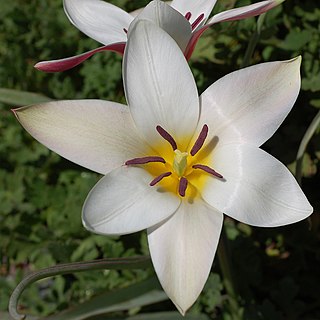
Tulipa clusiana, the lady tulip, is an Asian species of tulip native to Afghanistan, Iran, Iraq, Pakistan and the western Himalayas. It is widely cultivated as an ornamental and is reportedly naturalized in France, Spain, Portugal, Italy, Tunisia, Greece, and Turkey.
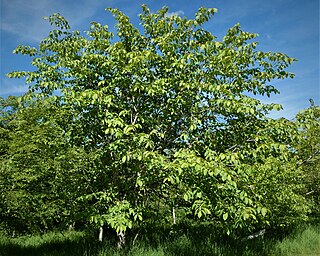
The elm Ulmus wallichiana subsp. xanthoderma was identified by Melville and Heybroek after the latter's expedition to the Himalaya in 1960. The tree is of more western distribution than subsp. wallichiana, ranging from Afghanistan to Kashmir.

Erodium cicutarium, also known as common stork's-bill, redstem filaree, redstem stork's bill or pinweed, is a herbaceous annual – or in warm climates, biennial – member of the family Geraniaceae of flowering plants. It is native to Macaronesia, temperate Eurasia and north and northeast Africa, and was introduced to North America in the eighteenth century, where it has since become naturalized, particularly of the deserts and arid grasslands of the southwestern United States.

Erodium malacoides is a species of flowering plant in the geranium family known by the common names Mediterranean stork's bill, soft stork's-bill and oval heron's bill. This is an annual or biennial herb which is native to much of Eurasia and North Africa but can be found on most continents where it is an introduced species.

Erodium cygnorum is a species of herb native to Australia.
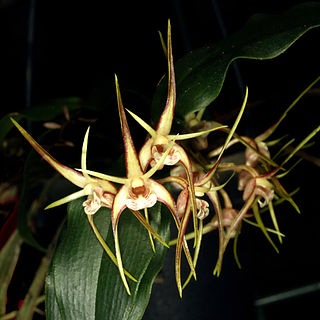
Dendrobium tetragonum, commonly known as the tree spider orchid, is a variable species of epiphytic or lithophytic orchid endemic to eastern Australia. Tree spider orchids are unusual in having pendulous pseudobulbs that are thin and wiry near the base then expand into a fleshy, four-sided upper section before tapering at the tip. There are only a few thin but leathery leaves at the end of the pseudobulbs and up to five flowers on relatively short flowering stems. To allow for the variations in the species there are five subspecies and a variety, some with a unique common name.
Pilosella floribunda is a species of noxious and herbaceous perennial plant from family Asteraceae that is known in Europe and can also be found in United States and Canada. It was believed that it was a hybrid of Pilosella caespitosa (Hieracium caespitosum and Pilosella lactucella.

Melaleuca pallida, commonly known as lemon bottlebrush, is a plant in the myrtle family, Myrtaceae and is endemic to eastern Australia. It is an upright shrub with thin, spreading branches, silvery new growth and pale yellow, sometimes pinkish bottlebrush flowers.
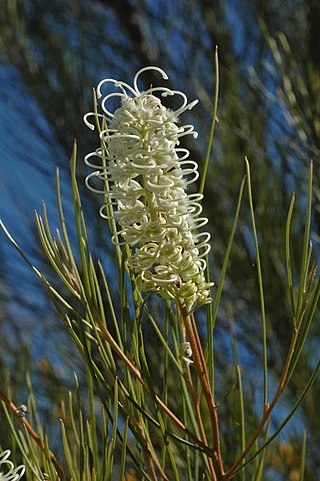
Grevillea pterosperma, commonly known as desert grevillea or desert spider-flower, is a species of flowering plant in the family Proteaceae and is endemic to continental Australia. It is an erect, rounded shrub with linear leaves, sometimes divided with up to six linear lobes, and cylindrical clusters of greyish white and creamy white flowers with a cream-coloured to pale yellow style.

Tabernaemontana pandacaqui, known as windmill bush and banana bush, is a species of plant in the dogbane family Apocynaceae.

Hypericum przewalskii, commonly called Przewalski's St. John's wort, is a flowering plant in Hypericumsect. Roscyna that is native to China.

Erodium glandulosum, called the black-eyed heron's bill, is a species of flowering plant in the genus Erodium, native to the Pyrenees. It has gained the Royal Horticultural Society's Award of Garden Merit.
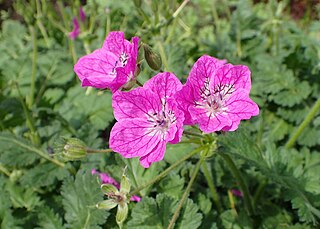
Erodium manescavi, called the garden stork's-bill, large purple storksbill, Manescau storksbill, Manescau heronsbill and showy heron's bill, is a species of flowering plant in the family Geraniaceae. It is native to the Pyrenees mountains of France, and has been introduced to Austria. As Erodium manescavii it has gained the Royal Horticultural Society's Award of Garden Merit.
Erodium sosnowskianum, or Sosonovskiy's heron's-bill, is a herbaceous plant, a species of the genus Erodium of the family Geraniaceae.
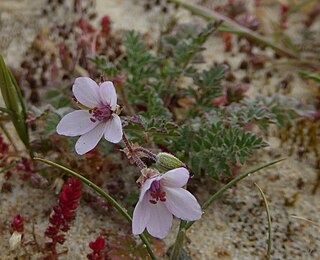
Erodium lebelii, sticky stork's-bill, is an annual plant in the family Geraniaceae. It occurs on sand dunes and heaths on the Atlantic and Mediterranean coasts of western Europe. Its taxonomic status is uncertain: some authorities consider it merely a variety or subspecies of common stork's-bill while others consider it to be the same as the north African species Erodium aethiopicum.


















